
Hamilton Hotel was the first hotel in Bermuda. Located on Church Street in Hamilton, construction began in 1852 and opened its doors in 1861. The hotel was instrumental in starting tourism in Bermuda. It was destroyed by fire in 1955. [1]

Hamilton Hotel was the first hotel in Bermuda. Located on Church Street in Hamilton, construction began in 1852 and opened its doors in 1861. The hotel was instrumental in starting tourism in Bermuda. It was destroyed by fire in 1955. [1]
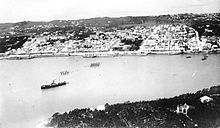
Construction was funded by the Corporation of Hamilton. [2] The foundation stone of this building was laid by the Governor of Bermuda, Capt. Charles Elliot, R.N., on August 19, 1852, during the term of Mayor Henry James Tucker. Elliot was assisted in the ceremony by the members of the Masonic lodges, and by the heads of the various Public Departments, Imperial and Colonial. Completed in the following year, it originally had 36 rooms.
On January 27, 1863, a subscription ball was held there, the string band of the Flagship H.M.S. Nile furnishing the music. April 21, 1863 a public dinner was given as a sort of opening of the Hamilton Hotel. D. A. Crowell (died August, 1888, Sohooley's Mountains, New Jersey) conducted the hotel for a short space. The American Civil War exerted a depressing influence on the fortunes of the hotel. In 1865, Joseph Rainey moved his barber shop from St. George's town to the town of Hamilton when an outbreak of yellow fever threatened St. George's. Rainey worked at the Hamilton Hotel as a barber and a bartender, becoming a respected member of the community. When regular steam communication with New York City was assured, the late Jeremiah Harnett took a lease from the Corporation and associated with himself the late Mr. Dodge. The lease then entered on formed the groundwork one between Walter Aiken and the Corporation of Hamilton. James Russell Mead assumed control for the season of 1894. [3] During the Second World War, the hotel housed a United Services Club for the recreation of Allied service personnel. The hotel was destroyed by fire December 23, 1955.


The original design comprized a two-storey centre (two which two additional floors, including an attic level, would be added) with two lateral wings and dining hall and kitchen in rear, the building being shaped as a capital The first addition made was a west wing, then extension of the dining room. The additions and alterations began in 1884 and completed 1886 altered entirely the whole aspect of the house and converted it into a hotel of large proportions. The old construction was carefully examined and wherever requisite either renewed or strengthened. In addition to the ordinary plastering, the whole building was painted externally. [3]
New and extensive tanks were provided added. In 1888, a well was bored and successfully completed, still further improving them. In 1890, a steam passenger elevator was provided and more tankage constructed, and an ice-making machine introduced. In 1891, ten more bedrooms were added in the attic extended over the west wing instead of the flat Bermudian stone roof. In 1892, the office and waiting-room were enlarged under a better arrangement. [3]
In 1909, it was enlarged and improved. There were then 260 rooms with baths, enough accommodation for 500 persons. It was substantial stone and concrete structure, lit with electricity and gas, and containing three elevators. There were 200 baths en-suite and numerous public baths on each floor. The hotel was heated by steam, and had open fires for cool days. The public rooms were large and comfortable, and an orchestra was provided.( Caledonian Publishing Company 1912 , p. 333)
Situated on high ground overlooking the town and harbor of Hamilton, it afforded good views, and was convenient to shops, churches, Government buildings, parade grounds and the golf and cricket fields.( Caledonian Publishing Company 1912 , p. 333) The grounds were laid out in terraces containing flowers and various shrubs, while the drive up and the steps for pedestrians were improved. To the northwest, adjoining the hotel in 1886, a new building called The Annex was erected, which afforded privacy to those staying there. [3]

The Sutro Baths was a large, privately owned public saltwater swimming pool complex in the Lands End area of the Outer Richmond District in western San Francisco, California.
The Statler Hotel company was one of the United States' early chains of hotels catering to traveling businessmen and tourists. It was founded by Ellsworth Milton Statler in Buffalo, New York.

The New York Biltmore Hotel was a luxury hotel at 335 Madison Avenue in Midtown Manhattan, New York City. The hotel was developed by the New York Central Railroad and the New York, New Haven and Hartford Railroad and operated from 1913 to 1981. It was one of several large hotels developed around Grand Central Terminal as part of Terminal City. The Biltmore was designed in the Italian Renaissance Revival style by Warren and Wetmore, one of the firms involved in designing Grand Central. Although the hotel's steel frame still exists, the hotel itself was almost entirely demolished and replaced by an office building in the early 1980s.

Joseph Hayne Rainey was an American politician. He was the first black person to serve in the United States House of Representatives and the second black person to serve in the United States Congress. His service included time as presiding officer of the House of Representatives.

The Hamilton Princess & Beach Club, A Fairmont Managed Hotel is one of the grandest and most famous hotels in Bermuda, located in Pembroke Parish just outside the City of Hamilton. It also happens to be the oldest hotel in the Fairmont chains. One of the largest in Bermuda, it has over 400 rooms. It is one of two Fairmont Hotels on the island, the second being the Fairmont Southampton, which was originally opened as the Southampton Princess.
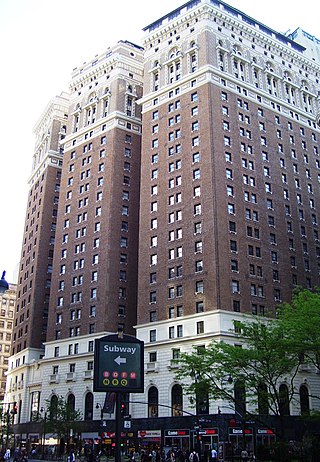
Herald Towers, formerly the Hotel McAlpin, is a residential condominium building on Herald Square, along Broadway between 33rd and 34th Streets, in the Midtown Manhattan neighborhood of New York City. Constructed from 1910 to 1912 by the Greeley Square Hotel Company, it operated as a short-term hotel until 1976. The building was designed by Frank Mills Andrews in the Italian Renaissance style and was the largest hotel in the world at the time of its completion, with 1,500 guestrooms. The hotel was expanded in 1917, when Warren and Wetmore designed an annex with 200 rooms.
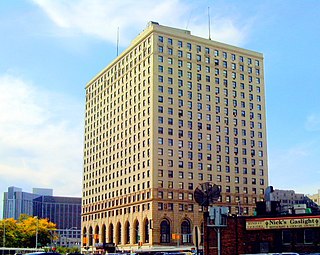
The Detroit-Leland Hotel is a historic hotel located at 400 Bagley Street in Downtown Detroit, Michigan. It is the oldest continuously operating hotel in downtown Detroit, and was listed on the National Register of Historic Places in 2005. The ballroom of the Detroit-Leland has hosted a nightclub, the City Club, since 1983. The hotel is now named The Leland and no longer rents to overnight guests.

Volcano House is the name of a series of historic hotels built at the edge of Kīlauea, within the grounds of Hawai'i Volcanoes National Park on the Island of Hawai'i. The original 1877 building is listed on the National Register of Historic Places and now houses the Volcano Art Center. The hotel in use today was built in 1941 and expanded in 1961.

The Victor Hotel is a historic hotel in the mining town of Victor, Colorado in the United States. The hotel is a four-story Victorian brick building built in 1899-1900 by the town's founders, the Woods brothers. It is on the National Register of Historic Places.

Buxton Crescent is a Grade-I-listed building in the town of Buxton, Derbyshire, England. It owes much to the Royal Crescent in Bath, but has been described by the Royal Institution of British Architects as "more richly decorated and altogether more complex". It was designed by the architect John Carr of York, and built for the 5th Duke of Devonshire between 1780 and 1789. In 2020, following a multi-year restoration and redevelopment project supported by the National Heritage Memorial Fund and Derbyshire County Council, The Crescent was reopened as a 5-star spa hotel.

The Corinthia Hotel Budapest at the Elizabeth Boulevard in Budapest, is a historic luxury hotel. Opened in 1896 as the Grand Hotel Royal, a hub for the elite of 19th century society, the hotel has undergone extensive modification throughout the 20th century, and has in the 21st century been restored and reopened as the Corinthia.

Chauncey Fitch Skilling (1868–1945) was a Los Angeles, California, architect who was also a member of that city's school board and of its city council.

Bimini Baths was a geothermal mineral water public bathhouse and plunge in what is now Koreatown, Los Angeles, California, US. It was situated just west of downtown, near Third Street and Vermont Avenue. Bimini Baths contained a natatorium, swimming pools, swimming plunge, Turkish baths, a medical treatment department, and bottling works.

The Waldorf Hotel was a hotel building in Fargo, North Dakota, US with entrances on Seventh and Front streets. It opened on April 1, 1899 and was demolished in 1951.
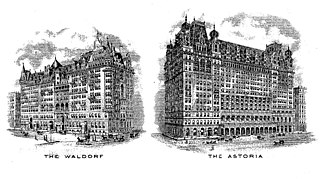
The Waldorf-Astoria originated as two hotels, built side by side by feuding relatives, on Fifth Avenue in New York, New York, United States. Built in 1893 and expanded in 1897, the hotels were razed in 1929 to make way for construction of the Empire State Building. Their successor, the current Waldorf Astoria New York, was built on Park Avenue in 1931.

Murray Hill Hotel was a hotel situated at 112 Park Avenue in Murray Hill, Manhattan, New York City. Built in 1884, with 600 rooms and two courtyards, it was demolished in 1947. It was part of the Bowman-Biltmore Hotels chain.

Albemarle Hotel was located at 1101 Broadway in the Flatiron District of Manhattan, New York City. Built in 1860 and overlooking Madison Square, it was one of the largest hotels on the avenue in its day.

The Morse Building, also known as the Nassau–Beekman Building and 140 Nassau Street, is a residential building in the Financial District of Manhattan in New York City, at the northeast corner of Nassau and Beekman Streets. The Morse Building, designed by Benjamin Silliman Jr. and James M. Farnsworth, contains elements of the Victorian Gothic, Neo-Grec, and Rundbogenstil style.
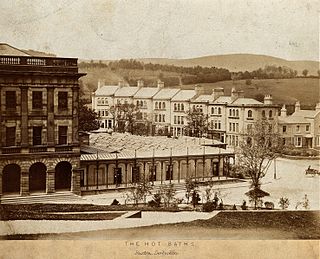
The Buxton Baths using natural thermal spring water are in Buxton, Derbyshire, England. The baths date back to Roman times and were the basis for developing Buxton as a Georgian and Victorian spa town. The present buildings of the Thermal Baths and the Natural Mineral Baths were opened in the 1850s. They are positioned either side of the Buxton Crescent at the foot of The Slopes in the town's Central Conservation Area. They are both Grade II listed buildings designed by Henry Currey, architect for the 7th Duke of Devonshire.

Furness Bermuda Line new service to Bermuda in the 1920s created the need of additional modern accommodations for the tourists coming to the island after the first World War. This lead for Furness Withy, parent company of the line, to begin buying existing hotels and purchasing land for this new demand. This led to the formation of the Bermuda Development Company which would Furness' new business development. Eventually the company would manage four main properties: The St George, The Mid Ocean Club, Bermudiana, and the Castle Harbor Hotel. The hotels would continue to see increased business and benefit from legislation passed that would prevent ships from being used as hotels in 1938. Furness Withy would eventually sell all its ownership in the hotels by 1958.